THE ULTIMATE DREAM
The tumultuous relationship between legendary Mexican artists Frida Kahlo and muralist Diego Rivera has inspired many films, books, operas, and musicals. El último sueño de Frida y Diego (The Last Dream of Frida and Diego) is a world premiere Spanish language opera that is co-commission by the San Diego Opera with San Francisco Opera, Fort Worth Opera, DePauw University School of Music, and with support from The University of Texas at Austin College of Fine Arts.
Frida Kahlo was arguably the greatest artist of magical realism. Her paintings were a uniquely Latin American mixture of the fantastic and the real. Unusually for her time, embraced her mixed-race heritage and had multiple affairs with men and women, making her a modern-day queer icon.
Diego Rivera, the greatest Mexican painter of the twentieth century, was an international art celebrity in his lifetime. Rivera’s contribution to modernism was the reintroduction of fresco painting into modern art and architecture. Their marriage was not a typical love story. They fought bitterly, had multiple extra-marital affairs, and divorced in 1939 only to remarry a year later.
In this world premiere opera, Grammy-winning composer Gabriela Lena Frank and Pulitzer-prize-winning playwright Nilo Cruz decided to forego a realistic biographical approach and created a libretto and soundscape steeped in magical realism and pre-Columbian Mexican folklore.
During the celebration of Día de Muertos (Day of the Dead), surrounded by candles and marigolds, a dying Diego Rivera longs to see his deceased wife Frida Kahlo once more. Catrina, the keeper of the souls, approaches Frida in the afterlife and explains that Diego desperately needs his beloved wife as the end of his life approaches. In a reversal of the Orpheus & Eurydice myth, Frida leaves the underworld to earth to guide Diego back with her to meet his fate. In a feminist twist, Kahlo doesn’t initially want to leave the world of the dead to walk with Rivera because he tormented her in life. She ultimately agrees to go back for the opportunity to re-paint rather than for him.
In addition to the “real world” and the underworld, the opera also has the third world, the world of art, which coexists with the living and the world of the dead. That world is represented by the character of a young crossdressing actor played by a countertenor.
Gabriela Lena Frank’s music is accessible, with lush harmonies interspersed with Latin folk music sounds with certain sections evoking Bartok’s forays into folk-inspired music and other sections evocative of horror movie music. While the score has no hooks or memorable arias, the dark score proved to be a hit with a local audience, many of whom came in Halloween attire.
As in his Pulitzer Prize-winning play Anna in the Tropics, Nilo Cruz’s libretto is chock full of linguistic imagery, lyricism, and metaphor. While evoking legendary Latin American writers such as Gabriel Garcia Marquez and Jorge Luis Borges, Cruz’s libretto has neither the early sexiness of Marquez’s best work nor Borges’ dark humor. Cruz’s flowery Spanish prose in lines such as “Una caricia puede costarte el recuerdo del dolor” (“A caress can cost you the memory of pain: and “Regreso a ti, mi arte” ( I return to you, my art) work well when musicalized but may come off as overwrought in English translation.
In pulling together this opera written and composed by two non-Mexican Latino artists, San Diego Opera assembled three Mexican opera singers as well as a Mexican conductor, Roberto Kalb, and a Mexican director, Lorena Maza.
Guadalupe Paz, an up-and-coming mezzo-soprano sings Frida. A protégé of composer Frank, Paz gives a committed and confident performance as Frida, giving a no-holds-barred performance of Frida as a tortured artist. Rather than attempting to produce beautiful tones, Paz’s singing and acting showed astonishing emotional nakedness and detailed veracity. Alfredo Daza, playing Diego, an accomplished dramatic Baritone with a thriving international career, sings beautifully but doesn’t quite convincingly succeed in showing the complex character of Diego as written – an international celebrity, a lonely man, a wife abuser, and a philanderer as well as madly in love with his wife.
Maria Katzarava, a regular at Covent Garden, plays the secondary role of Catrina, the Keeper of the Dead. Katzarava is an expressive singer with a great stage presence. Like Daza, she’s a dramatic singer with an accomplished list of Verdi roles under her belt. She nails the eerie character’s otherworldliness and deftly handles the work’s most difficult singing parts- lyrical singing interspersed with terrifying cackles.
Roberto Kalb drew a sensitive and lush performance from the San Diego Symphony, highlighting the sadness and despair in the score and providing impeccable support to the singers.
The San Diego Opera chorus under the direction of Bruce Stasyna sang well and convincingly played the parts of villagers in the first act and departed souls in the second act.
In the role of a cross-dressing actor, Key’mon Murra has an other-worldly tone that is perfect for playing a denizen of the underworld. His committed performance as a cross-dressing actor who impersonates Greta Garbo provided welcome comic relief.
Direction by Lorena Maza, an accomplished Mexico City theatre director, was somber and focused on creating eye-catching ci but static tableaus. Those tableaus included a marigold and candle cemetery and Casa Azul, Frida and Diego’s Mexico City home. Costumes by Eloise Kazan recreate some of the iconic costumes in Frida Kahlo’s paintings as well as dazzling dresses for Frida. Polychromatic Lighting by Victor Zapatero is effective in highlighting key moments and emotions.
Diego & Frida is the creators’ exploration of life, death, married love, Latin heritage, and the meaning of art. While its value as high art may be arguable, Frank and Cruz succeeded in creating an audience-pleasing opera that may supersede Catan’s Florencia de Las Amazonas as a Spanish-language standard of American opera house repertoire.
photos by Karli Cadel
El Último Sueño de Frida y Diego
San Diego Opera
San Diego Civic Theatre, 1100 Third Avenue
ends on Sunday Nov 6, 2022 at 2pm
for tickets, call 619-533-7000 or visit SD Opera
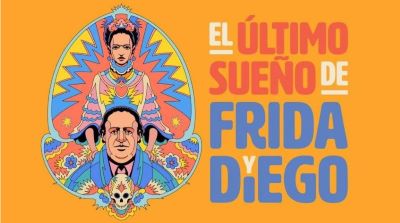
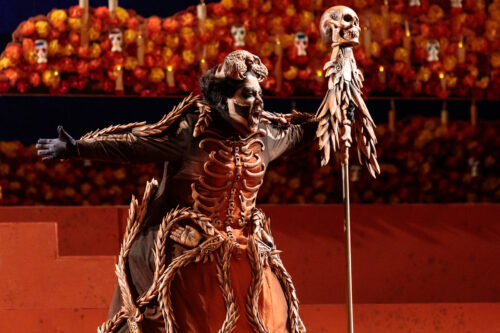
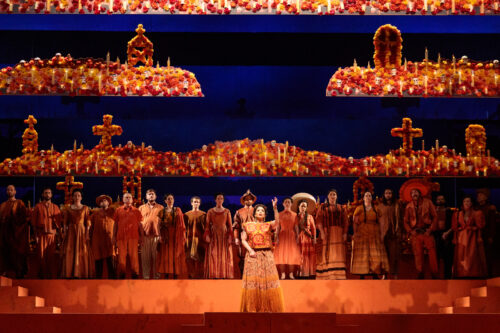
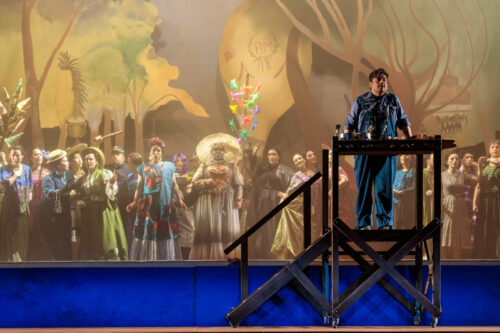
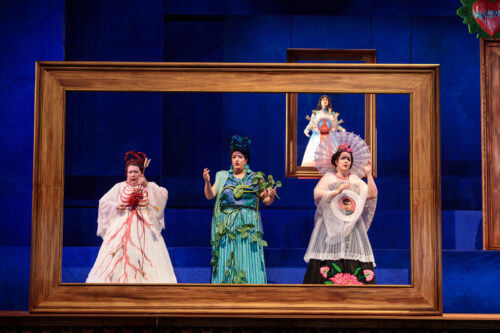
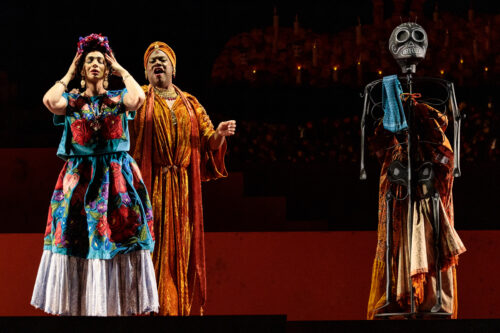
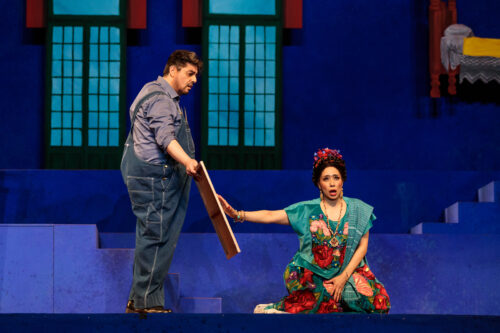
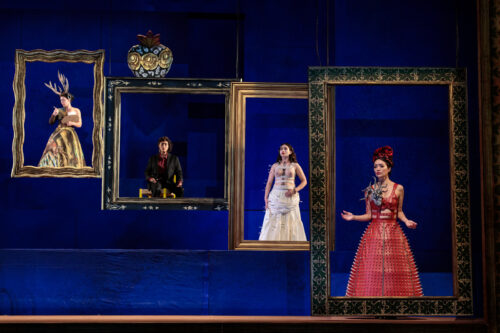

{ 1 comment… read it below or add one }
I dont understand why reviewers who publish their reviews are being so kind to the El Ultimo Sueno de Frida y Diego opera. I am of Mexican descent and have moved in and out, physically and in state of mind, between both my American and Mexican cultures all my lifetime. I attended the matinee performance on December 3rd at the Dorothy Chandler Pavilion.
When the performance begins, the musical rendering is one reminiscent of Hadestown. The sound is ominous, foreboding and enveloping. Since during the opening they are introducing the underworld and the dead, I thought okay this will be temporary. Miss Kahlo soon appears and is told by Catrina (the Keeper of Souls in the underworld) that Diego is pining for her to crossover to visit him. Here starts Frida’s long tirade explaining that she has already suffered too much and that the cause of most of her suffering is Diego. One would think; okay case and point made. For reasons I cannot seem to surmise, the powers that be chose to make this the central theme – Frida’s pain and suffering. Not only is most of the singing about her pain and suffering but the monotnous, dissonate tone permeates throughout the production. Almost the whole cast delivers their parts in the same omoinous tones. It feels more like a Greek tragedy. This opera might have been better welcomed if only the team that constructed it had sprinkled a few musical pieces with the lightheartedness of an optimistic corrido or a romantic ballad with a true Mexican arrangement. Not every song must be operatic – think of Fiddler on the Roof. One number had the the right type of tune and tone were it not that only two words are repeated endlessly as the lyric: Sin Ti.
I do not have the privilege of knowledge as to whether or not Mr. Nilo Cruz, the author of the libretto, was required to write the storyline as he did or if it was his own doing. Here was a great opportunity missed to present two of Mexico’s beloved historical icons and tell their complicated story with veracity (or fantasy), detail and tenderness. Sadly, instead we are only presented with Frida’s bitterness. If Frida is still so bitter in her afterlife, then why would she ever choose to crossover to Diego? Even IF there is a credible reason, it was never demonstrated in the performance. Their stories could have been presented with vignettes of fond memories and past devotions between them. Most people, of which Mexicans are no exception, do not languish and waddle in the thing which is causing pain and suffering; We break it up with moments of levity whether we dance, drink or simply enjoy the company of friends and family to seek RELIEF.
The good thing was the sets – very well done and replete with color. Wardrobe and makeup also did vibrant and imaginative work. Then there is a character named Leonardo awkwardly dropped into this opera. Leonardo is a Greta Garbo impersonator in the underworld who strongly desires to crossover on Dia de Los Muertos. Leonard is portrayed by Mr. Key’mon Murrah. Perhaps his character was inserted to provide much needed levity, although this could have been clervery accomplished via the main characters. But the good thing in this pesadilla (nightmare) is Mr. Murrah’s countertenor full-throated voice. It is not a harsh voice and there was a welcome sweetness in the lilt of it. His was the best voice in this opera.
Miss Frank and her creative team would have benefited well from seeing and studying the movies Coco and Book of Life. Yes they are products of animation and yet they display our Mexican culture so well.
Maybe they just focused too heavily on the word “opera.” The storyline spent so much time on Frida’s suffering and many of us became restless and or bored: This opera never took us to a place of respite to breathe a sigh of relief. Oh what a wonderful product this could have been if only couterbalanced with hopefulness, joy and a bit of our Mexican musicality.